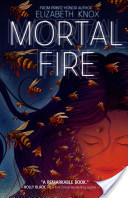Sixteen-year-old Agnes Mochrie, aka Canny, stars as the protagonist in Elizabeth Knox’s new fantasy novel Mortal Fire. This novel is set in 1959 in Southland, the same locale as the famous Dreamhunter Duet.
 Canny, a Pacific Islander who attends Castlereagh Tech, is a math genius and the star of the school’s math team—a gender marvel for the time period. But then, much about Canny is a marvel—from her massive, impassive, and queenly mother who presides over Canny’s life like an unexploded bomb to Canny’s admirable loyalty to her polio afflicted friend Marli.
Canny, a Pacific Islander who attends Castlereagh Tech, is a math genius and the star of the school’s math team—a gender marvel for the time period. But then, much about Canny is a marvel—from her massive, impassive, and queenly mother who presides over Canny’s life like an unexploded bomb to Canny’s admirable loyalty to her polio afflicted friend Marli.
Readers are certain about the depth of Knox’s book early in, when Canny’s step-brother, Sholto begins experiencing impressions and apparitions regarding his sister and when Canny describes an uncanny ability to perceive with “Extra” insight. By careful observation and with an alert and capacious memory, Canny is not only able to understand and solve complicated equations but to understand and perform magic. Her power of perception strengthens when she and her brother travel to the mysterious and magical ZareneValley, a pastoral paradise that turns menacing.
Taught to believe she is exceptional and misshapen, Canny struggles with her identity and to accept all the possibility of her life, given her “horrible talent.” From teachers, snotty boys, nasty girls, and even her own mother, Canny has learned that she has “a great talent with limited usefulness” (268), one that makes her “unbecoming.” But the novel transcends the coming of age, adolescent identity crisis plot to become much more as it explores the repercussions of two human tendencies: our effort to save/rescue others and our desire to punish people who harm us.
To develop these themes, Knox’s book features a strong female protagonist, one who has a calculating mind able to put “terrifying and strange stuff behind her and [form] a new plan” (366). Despite her physical and emotional distress, Canny—no damsel in distress—persists to escape adversity and to solve problems independently. In the process, she learns various truths about self-acceptance and love.
Although elements of the novel clearly consign it to the fantasy genre, much of the book’s tapestry is woven with historical fiction: World War Two, coal mining disasters of 1929, beekeeping, and polio epidemics. These features not only enrich the plot but lend to the book a broader audience appeal.
- Posted by Donna


Thank you for the review.